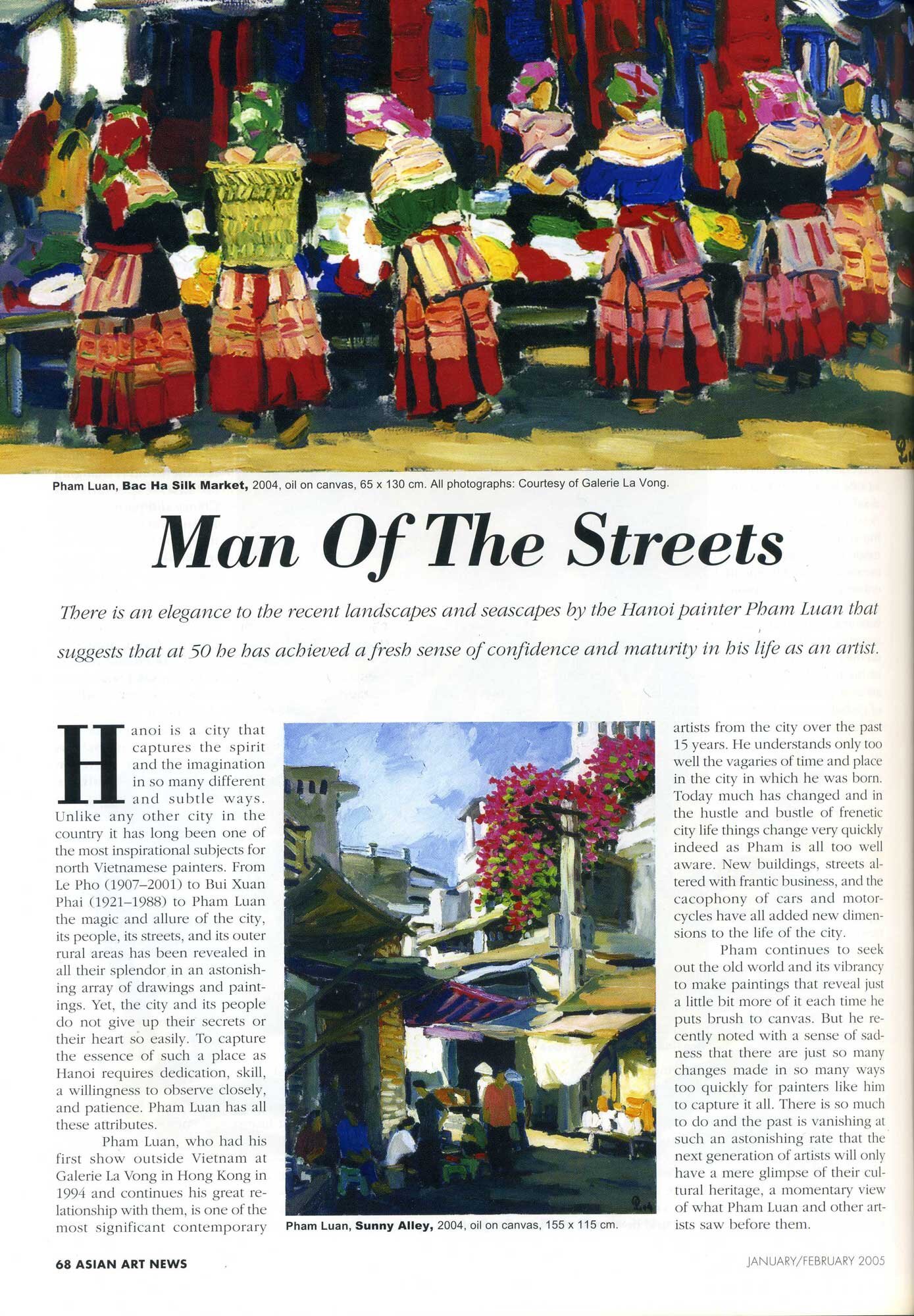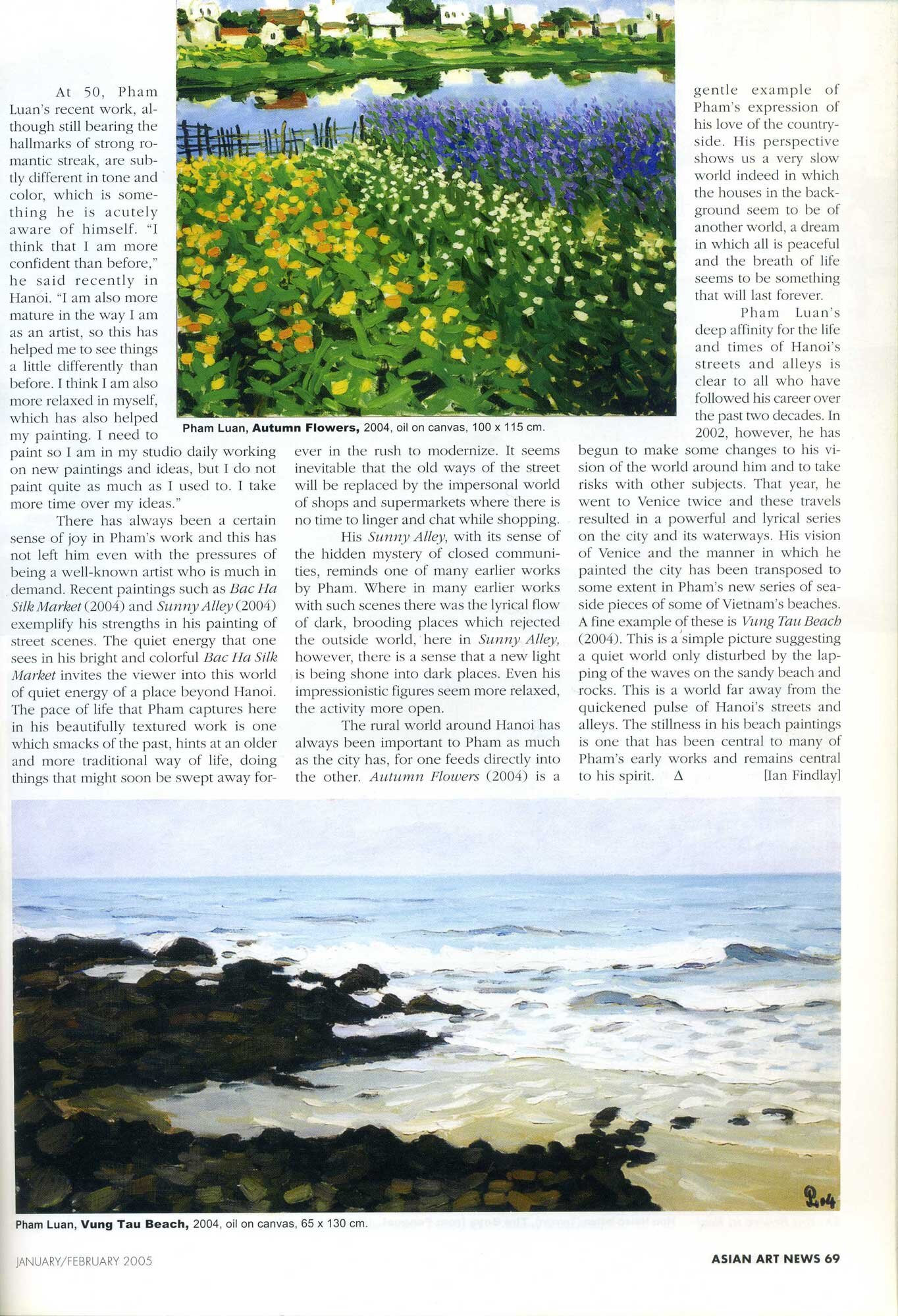Man of the Streets
by Ian Findlay
Bac Ha Silk Market. 2004
There is an elegance to the recent landscapes and seascapes by the Hanoi painter Pham Luan that suggests that at 50 he has achieved a fresh sense of confidence and maturity in his life as an artist.
Hanoi is a city that captures the spirit and the imagination in so many different and subtle ways. Unlike any other city in the country it has long been one of the most inspirational subjects for north Vietnamese painters. From Le Pho (1907-2001) to Bui Xuan Phai (1921-1988) to Pham Luan the magic and allure of the city, its people, its streets, and its outer rural areas has been revealed in all their splendor in an astonishing array of drawings and paintings. Yet, the city and its people do not give up their secrets or their heart so easily. To capture the essence of such a place as Hanoi requires dedication, skill, a willingness to observe closely, and patience. Pham Luan has all these attributes.
Pham Luan, who had his first show outside Vietnam at Galerie La Vong in Hong Kong in 1994 and continues his great relationship with them, is one of the most significant contemporary artists from the city over the past 15 years. He understands only too well the vagaries of time and place in the city in which he was born. Today much has changed and in the hustle and bustle of frenetic city life things change very quickly indeed as Pham is all too well aware. New buildings, streets altered with frantic business, and the cacophony of cars and motorcycles have all added new dimensions to the life of the city.
Pham continues to seek out the old world and its vibrancy to make paintings that reveal just a little bit more of it each time he puts brush to canvas. But he recently noted with a sense of sadness that there are just so many changes made in so many ways too quickly for painters like him to capture it all. There is so much to do and the past is vanishing at such an astonishing rate that the next generation of artists will only have a mere glimpse of their cultural heritage, a momentary view of what Pham Luan and other artists saw before them.
At 50, Pham Luan’s recent work, although still bearing the hallmarks of strong romantic streak, are subtly different in tone and color, which is something he is acutely aware of himself. “I think that I am more confident than before,” he said recently in Hanoi. “I am also more mature in the way I am as an artist, so this has helped me to see things a little differently than before. I think I am also more relaxed in myself, which has also helped my painting. I need to paint so I am in my studio daily working on new paintings and ideas, but I do not paint quite as much as I used to. I take more time over my ideas.”
There has always been a certain sense of joy in Pham’s work and this has not left him even with the pressures of being a well-known artist who is much in demand. Recent paintings such as Bac Ha Silk Market (2004) and Sunny Alley (2004) exemplify his strengths in his painting of street scenes. The quiet energy that one sees in his bright and colorful Bac Ha Silk Market invites the viewer into this world of quiet energy of a place beyond Hanoi. The pace of life that Pham captures here in his beautifully textures work is one which smacks of the past, hints at an older and more traditional way of life, doing things that might soon be swept away forever in the rush to modernize. It seems inevitable that the old ways of the street will be replaced by the impersonal world of shops and supermarkets where there is no time to linger and chat while shopping.
His Sunny Alley, with its sense of the hidden mystery of closed communities, reminds one of many earlier works by Pham. Where in many earlier works with such scenes there was the lyrical flow of dark, brooding places which rejected the outside world, here in Sunny Alley, however, there is a sense that a new light is being shone into dark places. Even his impressionistic figures seem more relaxed, the activity more open.
The rural world around Hanoi has always been important to Pham as much as the city has, for one feeds directly into the other. Autumn Flowers (2004) is a gently example of Pham’s expression of his love of the countryside. His perspective shows us a very slow world indeed in which the houses in the background seem to be of another world, a dream in which all is peaceful and the breath of life seems to be something that will last forever.
Pham Luan’s deep affinity for the life and times of Hanoi’s streets and alleys is clear to all who have followed his career over the past two decades. In 2002, however, he has begun to make some changes to his vision of the world around him and to take risks with other subjects. That year, he went to Venice twice and these travels resulted in a powerful and lyrical series on the city and its waterways. His vision of Venice and the manner in which he painted the city has been transported to some extent in Pham’s new series of seaside pieces of some of Vietnam’s beaches. A fine example of these is Vung Tau Beach (2004). This is a simple picture suggesting a quiet world only disturbed by the lapping of the waves on the sandy beach and rocks. This is a world far away from the quickened pulse of Hanoi’s streets and alleys. The stillness in his beach paintings is one that has been central to many of Pham’s early works and remains central to his spirit.


